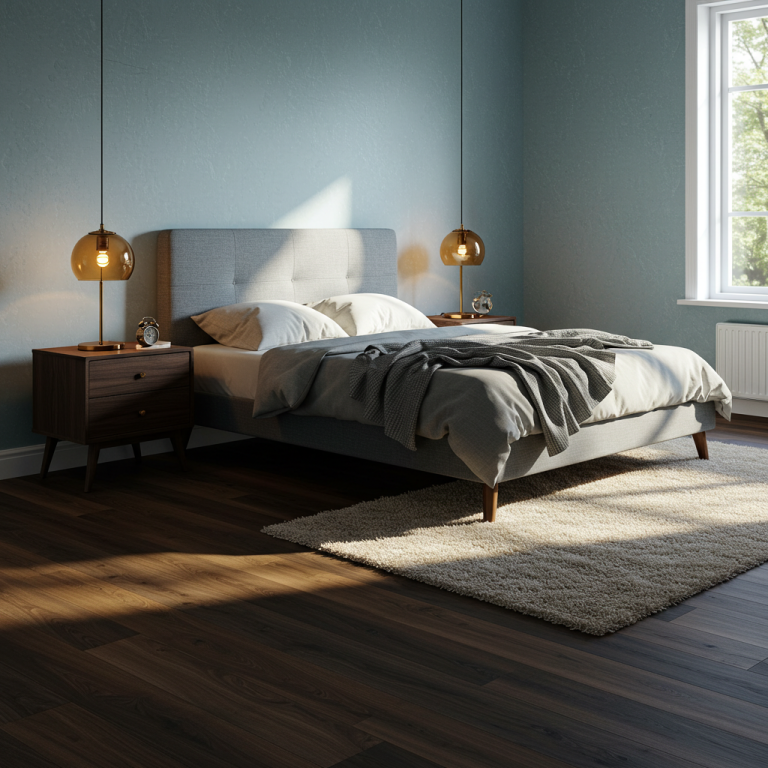20 Tile Flooring Ideas for a Stylish and Functional Living Room

Introduction
Your living room is where family gathers, friends visit, and everyday life unfolds. It’s the most visible space in your home, and the flooring you choose can dramatically influence both the style and functionality of the space. While many people think of wood, carpet, or vinyl, tile flooring is becoming a favorite option for living rooms — and for good reason.

Tiles aren’t just practical; they’re incredibly versatile. They come in a variety of materials like ceramic, porcelain, marble, slate, and even patterned cement. They can be arranged in different patterns, cut into unique shapes, or combined with other materials for a completely personalized look. Plus, tile floors are known for being durable, easy to clean, and allergy-friendly.
In this guide, we’ll explore 20 living room tile flooring ideas, from classic elegance to bold, artistic designs. You’ll find details on styles, best use cases, pros and cons, and tips for pairing each tile with your décor.
1. Classic Ceramic Tiles
Ceramic tiles are one of the most widely used flooring types, known for their affordability, variety, and ease of maintenance. They come in almost every color, pattern, and finish imaginable.
Best for: Traditional, casual, or transitional living rooms.
Pros: Budget-friendly, water-resistant, low-maintenance.
Cons: Slightly less durable than porcelain, can chip if hit with heavy objects.
Design tip: Use warm-toned ceramic tiles to create a cozy, inviting feel.

2. Porcelain Tiles
Porcelain is a type of ceramic tile that is denser and less porous, making it more durable and stain-resistant. It’s ideal for high-traffic areas like the living room.
Best for: Busy families or open-plan spaces that connect to kitchens and patios.
Pros: Stronger than ceramic, suitable for indoor-outdoor continuity.
Cons: Can be harder to cut during installation.
Design tip: Large-format porcelain tiles give a seamless, modern look.

3. Wood-Look Tiles
These tiles mimic the grain, texture, and warmth of hardwood but offer the durability of tile.
Best for: Homes with pets, kids, or moisture-prone areas.
Pros: Scratch- and water-resistant, realistic wood appearance.
Cons: Colder underfoot than real wood.
Design tip: Choose a light oak or walnut tone for a versatile, timeless style.
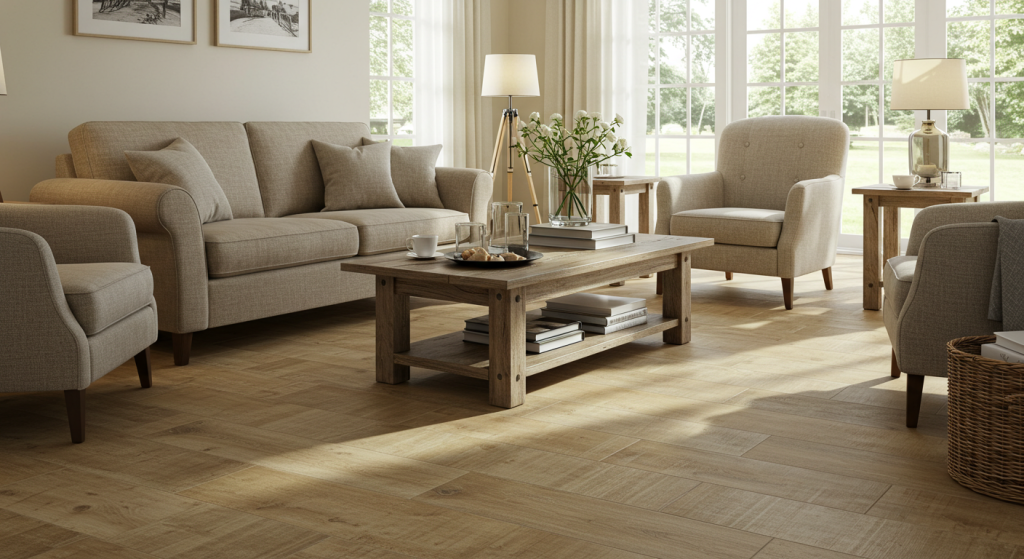
4. Marble Tiles
Marble is the ultimate statement in luxury flooring. Its veining patterns are unique to each piece, adding sophistication to your living room.
Best for: High-end, classic interiors.
Pros: Elegant, timeless, increases home value.
Cons: Expensive, requires sealing, can be slippery.
Design tip: Use matte or honed marble for better slip resistance.
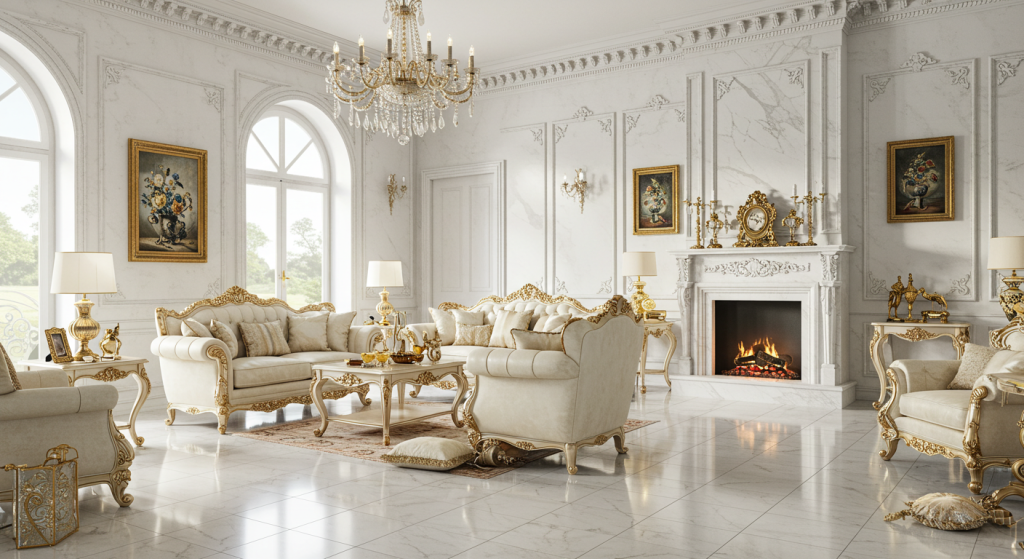
5. Slate Tiles
Slate offers a rugged, natural beauty with deep earthy colors like grey, black, rust, and green.
Best for: Rustic, lodge-style, or bohemian living rooms.
Pros: Very durable, slip-resistant, natural texture.
Cons: Can be uneven underfoot unless leveled.
Design tip: Pair slate with leather furniture and warm lighting for a cozy vibe.

6. Travertine Tiles
Travertine has a soft, classic look in beige, cream, and ivory shades.
Best for: Mediterranean or Tuscan-inspired spaces.
Pros: Naturally beautiful, timeless.
Cons: Porous — needs sealing.
Design tip: Use a tumbled finish for a softer, aged effect.
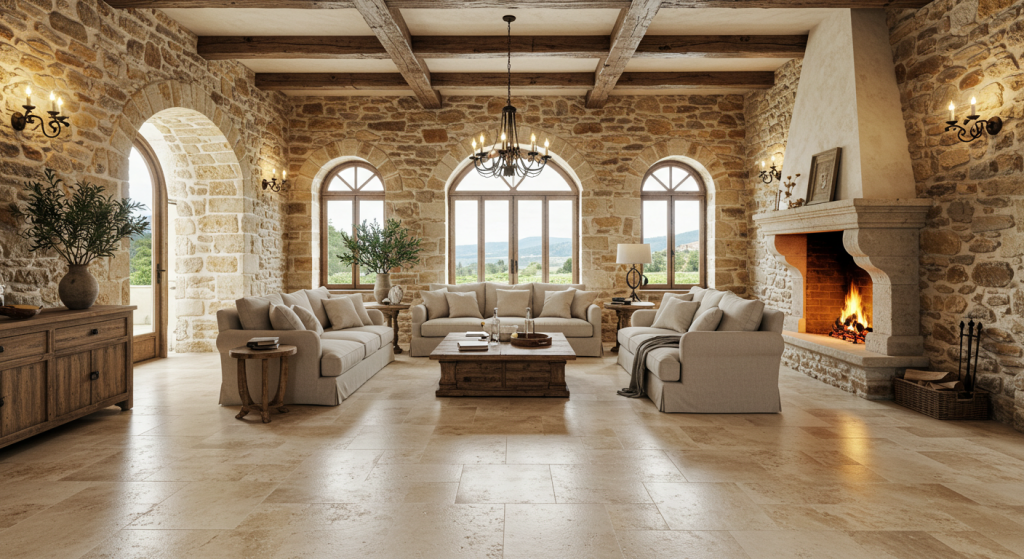
7. Glossy White Tiles
Perfect for small living rooms that need more light.
Best for: Minimalist or coastal designs.
Pros: Reflects light, makes spaces feel bigger.
Cons: Shows dirt easily.
Design tip: Balance the brightness with warm-toned furniture and rugs.

8. Matte Finish Tiles
Matte tiles are non-reflective, making them a comfortable choice for relaxed spaces.
Best for: Cozy, rustic, or farmhouse interiors.
Pros: Hides dirt better, slip-resistant.
Cons: Less light reflection.
Design tip: Pair matte tiles with textured fabrics for a layered look.

9. Mosaic Tile Accents
While not common for entire living rooms, mosaics make stunning borders, medallions, or inlays.
Best for: Artistic focal points.
Pros: Customizable, adds personality.
Cons: More expensive per square foot.
Design tip: Use mosaic accents in the center of the room or around a fireplace.
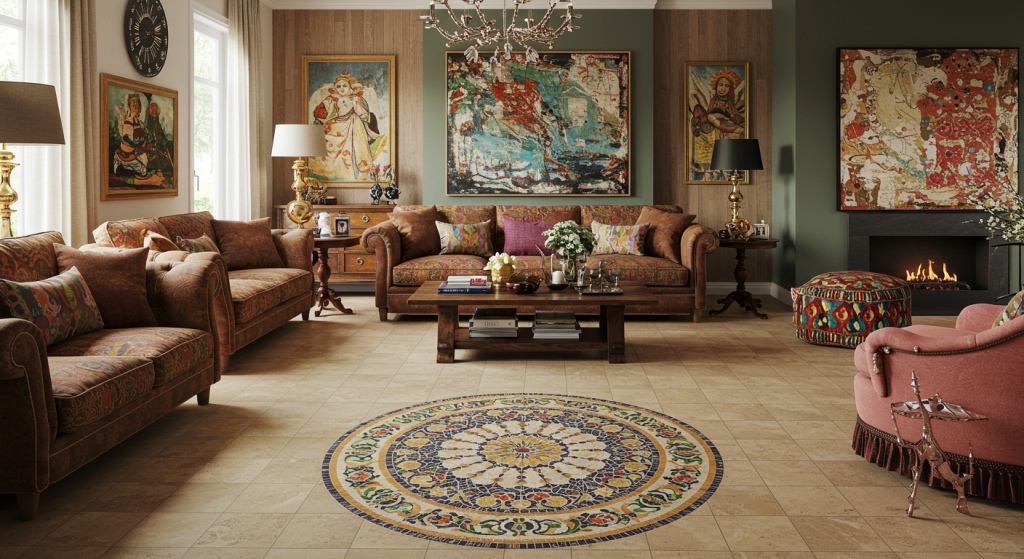
10. Patterned Cement Tiles
Known for bold designs, Moroccan and encaustic cement tiles add instant drama.
Best for: Bohemian or eclectic spaces.
Pros: Unique, colorful, handmade charm.
Cons: Requires sealing, can fade in direct sunlight.
Design tip: Pair with plain furniture to let the flooring shine.

11. Hexagon Tiles
Geometric shapes like hexagons create a fresh, modern feel.
Best for: Contemporary or retro-inspired homes.
Pros: Eye-catching, versatile.
Cons: Slightly more complex installation.
Design tip: Use a single neutral color for subtlety or mix shades for a playful effect.

12. Large-Format Tiles
Tiles measuring 24 inches or more reduce grout lines, creating a sleek, spacious look.
Best for: Modern, minimalist spaces.
Pros: Clean lines, less grout maintenance.
Cons: Heavier, requires a level subfloor.
Design tip: Choose soft grey or beige for a sophisticated backdrop.

13. Terracotta Tiles
Terracotta offers warm, earthy charm.
Best for: Farmhouse, southwestern, or rustic interiors.
Pros: Warm color palette, natural look.
Cons: Needs sealing, can chip.
Design tip: Pair with natural wood furniture and neutral textiles.

14. Textured Tiles
Tiles with raised or embossed textures add dimension.
Best for: Adding tactile interest to neutral designs.
Pros: Hides dirt, unique feel underfoot.
Cons: Harder to clean.
Design tip: Great for feature areas like entry zones in the living room.
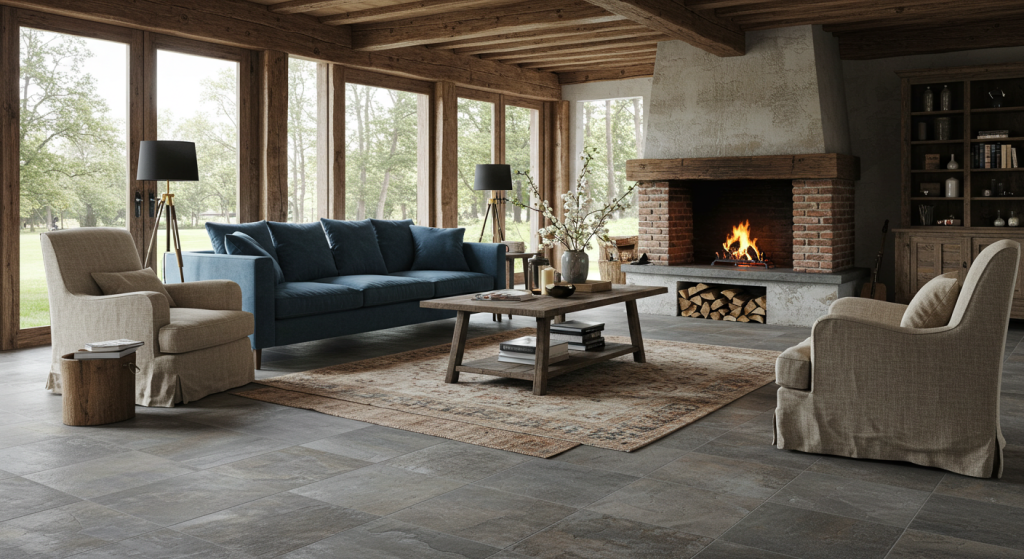
15. High-Gloss Tiles
Shiny finishes enhance luxury and reflect light.
Best for: Glamorous interiors.
Pros: Reflective, modern.
Cons: Slippery when wet.
Design tip: Use rugs to balance shine with warmth.

16. Black Tiles
Bold and moody, black tiles make a statement.
Best for: Modern, industrial, or luxe spaces.
Pros: Dramatic, hides stains well.
Cons: Shows dust easily.
Design tip: Pair with metallic accents for a chic contrast.
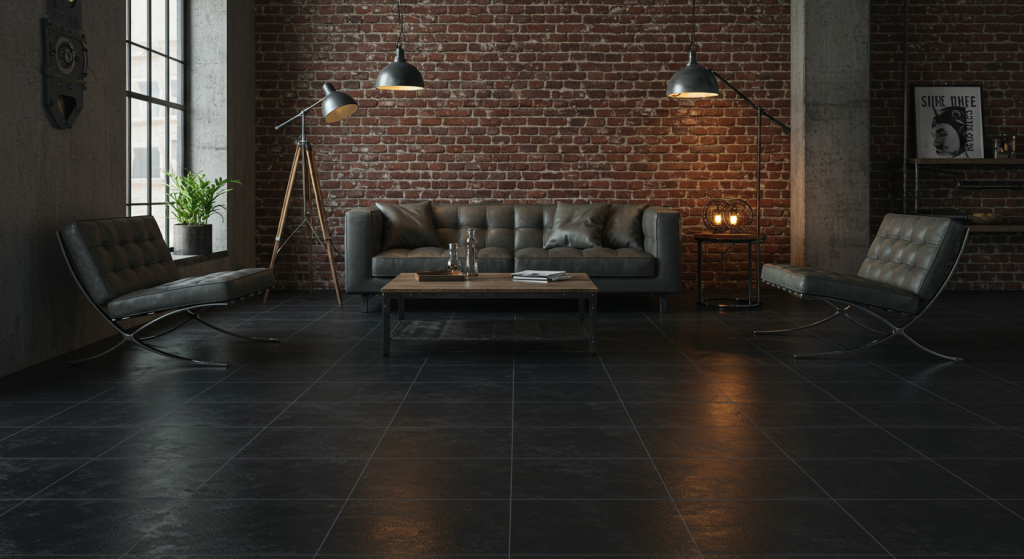
17. Checkerboard Pattern
Black-and-white or other contrasting tiles create retro charm.
Best for: Vintage or eclectic designs.
Pros: Timeless, high visual impact.
Cons: Can overwhelm small spaces.
Design tip: Keep walls neutral to let the pattern stand out.

18. Two-Tone Layouts
Mix two complementary colors in a strategic layout.
Best for: Subtle visual interest without heavy patterns.
Design tip: Try a border effect using a darker shade around the room.

19. Diagonal Layout
Laying tiles diagonally tricks the eye into seeing more space.
Best for: Small living rooms.
Design tip: Works well with both plain and patterned tiles.
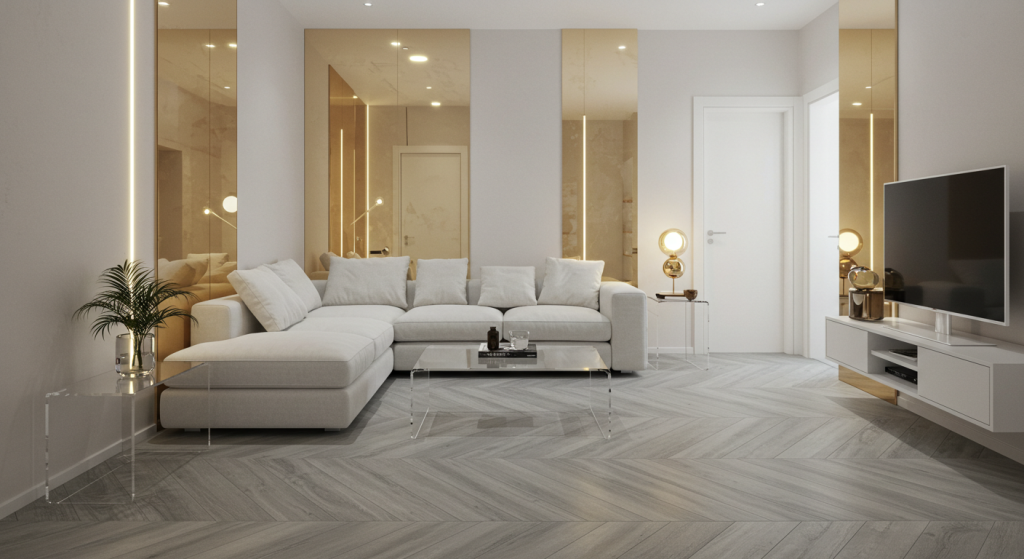
20. Mixed Material Tiles
Combine tile with hardwood or carpet for functional zoning in open-plan homes.
Best for: Multi-purpose living rooms.
Design tip: Use tile in high-traffic zones and warmer materials in seating areas.

How to Choose the Right Living Room Tile
- Consider lifestyle: Pets, kids, or frequent guests may require more durable and scratch-resistant options.
- Match the style: Your tile should complement walls, furniture, and décor.
- Factor in climate: Tiles are naturally cool — great for warm climates, but add rugs in cooler regions.
- Plan for maintenance: Natural stone requires sealing; ceramic is almost maintenance-free.
Conclusion
Tile flooring offers a unique blend of beauty, practicality, and design flexibility. Whether you want the sophistication of marble, the rustic charm of terracotta, or the boldness of patterned cement, there’s a living room tile that can bring your vision to life. By understanding the different materials, patterns, and finishes, you can choose a tile floor that reflects your personal style while standing up to everyday life.




